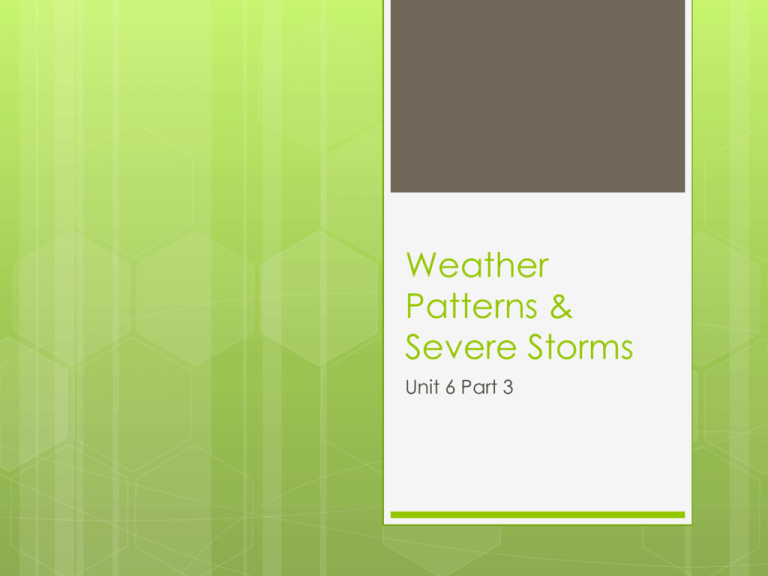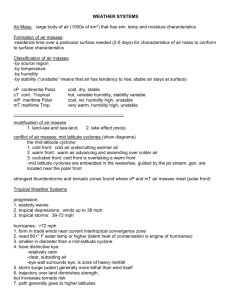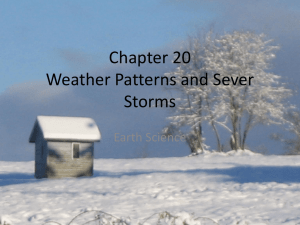File
advertisement

Weather Patterns & Severe Storms Unit 6 Part 3 What is an air mass? How do air masses affect you? Can you predict the outcome of two air masses meeting? Can you explain how air masses are classified? How are cP and cT similar? How are they different? Air Masses Characteristics Large body of air 1600 km (1000 mi) or more across Several km thick Similar temperatures at any given altitude Similar moisture at any given altitude Move and affect large part of continent Air Masses Source region – the place where an air mass acquires it’s properties Air Masses Classification of an air mass Two criteria are used to classify By the nature of the surface in the source region Continental (c) Form over land Likely to be dry Maritime (m) Originate over water Humid air Air Masses By the latitude of the source region Polar (P) High latitudes Cold Tropical (T) Low latitudes Warm Air Masses Four basic types of air masses Continental polar (cP) Continental tropical (cT) Maritime polar (mP) Maritime tropical (mT) Air Masses Air Masses Air masses and Weather cP and mT air masses are the most important in North America, especially east of the Rockies Air Masses North America (east of the Rockies) Continental polar From northern Canada and interior of Alaska Winter – brings cold, dry air Summer – brings cool relief Responsible for Lake effect snows cP air mass crosses the Great Lakes Air picks up moisture from the lakes Snow occurs on the leeward shores of the lakes Air Masses Maritime tropical From the Gulf of Mexico and the Atlantic Ocean Warm, moist, unstable air Brings precipitation to the eastern U.S. Air Masses Continental tropical Southwest and Mexico Hot, dry Seldom important outside the source region Air Masses Maritime Polar Brings precipitation to the western mountains Occasional influence in the northeastern U.S. causes the “northeaster” in New England with its cold temperatures and snow What is an air mass? How do air masses affect you? Can you predict the outcome of two air masses meeting? Can you explain how air masses are classified? How are cP and cT similar? How are they different? What is a front? How are fronts related to air masses? What is likely to happen if a cold front is approaching? How would you describe the sequence clouds as a warm front approaches? What do you notice about the weather AFTER a front passes? Fronts Boundary that separates air masses Air masses retain their identities Warmer, less dense air forced aloft Cooler, denser air acts as a wedge Fronts Types of fronts Warm front Warm air replaces cooler air Shown on a map with semicircles Small slope Clouds become lower as front nears Slow rate of advance Light-to-moderate precipitation Gradual temperature increase with the passage of the front Fronts Cold front Cold air replaces warm air Shown on a map with triangles Twice as steep as warm fronts Fronts Advances faster than a warm front Weather more violent than a warm front Intensity of precipitation is greater Duration of precipitation is shorter Weather behind the front is dominated by Cold air mass Subsiding air Clearing conditions Fronts Stationary front Flow of air on both sides of the front is almost parallel Surface position of the front does not move Fronts Occluded front Active cold front takes over a warm front Cold air wedges warm air upward Weather is often complex Precipitation is associated with air being forced aloft What is a front? How are fronts related to air masses? What is likely to happen if a cold front is approaching? How would you describe the sequence clouds as a warm front approaches? What do you notice about the weather AFTER a front passes? Mid-Latitude Cyclones Middle-Latitude Cyclones Primary weather producer in the middle latitudes Life cycle Originate along a front where air masses are moving parallel to the front in opposite directions Continental polar (cP) air is often north of the front Maritime tropical (mT) air is often south of the front Mid-Latitude Cyclones Frontal surface takes on a wave shape with low pressure centered a the apex of the wave Warm front and cold front form Cold front catches up to warm front and produces an occlusion Warm sector is forced aloft Fronts discontinue Storm comes to an end Mid-Latitude Cyclones General characteristics Large center of low pressure Counter clockwise air circulation Air flows inward toward center Mid-Latitude Cyclones Travels west to east guided by the westerlies Last a few days to more than a week Extending from the center of the low are a Cold front, and Frequently a warm front Mid-Latitude Cyclones Convergence and forceful lifting cause Cloud development Abundant precipitation Mid-Latitude Cyclones Idealized weather Middle-latitude cyclones move eastward across the U.S. First signs of their approach are to the west Require two to four days to pass Largest weather contrasts occur in the spring Mid-Latitude Cyclones Changes in weather associated with the passage of a middle-latitude cyclone Changes depend on the path of the storm Weather associated with fronts Mid-Latitude Cyclones Warm front Clouds become lower, thicker Light precipitation Perhaps over a large area Perhaps of prolonged duration After the passage of a warm front Winds become more southerly Warmer air temperatures (mT air mass) Mid-Latitude Cyclones Cold front Wall of dark clouds Heavy precipitation Narrow band along the front Short duration After the passage of a cold front Wind becomes north to northwest Drop in temperature as a cP air mass moves in Clearing skies Mid-Latitude Cyclones Role of Air Aloft Cyclones and anticyclones Generated by upper-level air flow Maintained by upper-level air flow Mid-Latitude Cyclones Cyclone Low pressure system Surface convergence Outflow (divergence) aloft sustains the low pressure Mid-Latitude Cyclones Anticyclone High pressure system Associated with cyclones Surface divergence Convergence aloft Thunderstorm Thunderstorm Features Cumulonimbus Heavy clouds rainfall Lightning Occasional hail Thunderstorm Occurrence 2000 in progress at any one time 100,000 per year in U.S. Most frequent in Florida Eastern Gulf Coast Region Thunderstorm Stages of development All thunderstorms require Warm air Moist air Instability High surface temps Most common in the afternoon Thunderstorm Require continual supply of warm air Each surge causes air to rise higher Updrafts and downdrafts form Eventually precipitation forms Most active stage Gusty winds, lightening, hail Heavy precipitation Cooling effect of precipitation marks the end of the thunderstorm activity Tornados Tornado Local storm of short duration Features Violent windstorm Rotating column of air Extends down from a cumulonimbus cloud Low pressure inside causes air to rush to center Winds approach 480 km (300 miles) per hour Tornados Occurrence and development Average 780 each year in U.S. – more than any other country! Most frequent from April – June Associated with severe thunderstorms Exact cause of tornadoes is not known Tornados Conditions for the formation of tornadoes Occur most often along a cold front During spring months Associated with intense thunderstorms Tornados Characteristics Diameter between 150 and 600 meters Speed across landscape is about 45 kilometers per hour Cut about a 10km long path Most move toward the northeast Maximum winds are bout 480 km/h Intensity measured by the Fujita intensity scale Tornados Tornado Forecasting Difficult to forecast because of their small size Tornado watch To alert people Issued when conditions are favorable Covers 65,000 square km Tornados Tornado warning is issued when funnel cloud is sighted or is indicated by radar Use of Doppler radar helps increase the accuracy by detecting the air motion Hurricanes Hurricane Most Violent Storm on Earth To be called a hurricane Wind speed in excess of 119 km/h (72 mph) Rotary circulation Hurricanes Features Tropical cyclone Low pressure (lowest pressure system in the Western Hemisphere) Steep pressure gradient Rapid, inward-spiraling wind Hurricanes Parts of a hurricane Eyewall Near the center Rising air Intense convective activity Wall of cumulonimbus clouds Greatest wind speeds Heaviest rainfall Hurricanes Eye At the very center About 20km diameter Precipitation ceases Wind subsides Air gradually descends and heats Warmest part of the storm Hurricanes Wind speeds reach 300 km/hr Generate 50 foot waves at sea Cause great damage on land Known by different names Typhoon in western Pacific Cyclone in Indian Ocean Hurricanes Frequency Most (20 per year) occur in the Northern Atlantic Fewer than 5 occur in the warm North Pacific Hurricanes Hurricane formation and decay Form in all tropical waters except the South Atlantic (1 exception) and Eastern South Pacific Energy comes from condensing water vapor Hurricanes Develop most in late summer when warm water temperatures provide energy and moisture Initial stage is not well understood Tropical depression – winds do not exceed 61km/h Tropical storm – winds 61-118 km/hr Hurricanes Diminish in intensity whenever They move over cooler ocean water The move onto land The flow aloft is unfavorable Hurricanes Destruction from a hurricane Factors that affect amount of hurricane damage Strength of storm (the most important factor) Size and population density Shape of the ocean bottom near the shore Hurricanes Categories of hurricane damage Wind damage Storm surge Large dome of water 65-80 km long Greatest threat along coastline Where eye makes landfall Inland freshwater flooding from torrential rains More people die from flooding each year than anything else!








